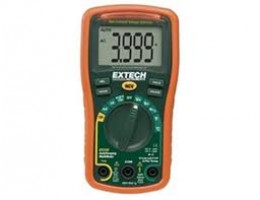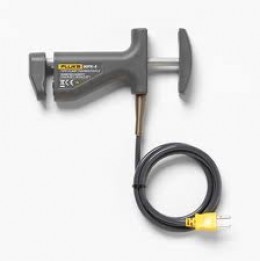The EXTECH MultiMeter
The
EXTECH multimeter is a fine, high quality multimeter for any type of
electrical troubleshooting or service work. Recently, in another hub I
discussed the Fluke Electronics company, and one of their fine digital
tools that I own, the Fluke 971 digital thermometer and humidity meter.
While I've owned more than one fine Fluke Electronics multimeter; my
current multimeter that I use for HVAC work is an EXTECH multimeter. I
do also own a Fluke 30 multimeter, and I do use it as well; but I use it
for different HVAC troubleshooting needs, and I'll explain some more
about that here in a bit. There is, however, nothing that the EXTECH
multimeter can not do, provided that you purchase additional add on
tools for the applications that you seek to add to your troubleshooting
set.
The EXTECH MultiMeter

Source
Why the EXTECH?
I
purchase my EXTECH multimeter simply because it was a less expensive
meter than the similar models offered by the more well known Fluke
Electronics company. I'd just started a new job with a new HVAC
and plumbing company, and I didn't have all of the tools that I needed.
Yes, I did have the Fluke 30 multimeter that I mentioned, and that's a
great meter.
It only does not provide you with the capabilities of checking DC voltage, and it also doesn't have the capability to read microfarads, or "capacitance" in regards to a capacitor. Knowing the capacitance of a given capacitor is essential in HVAC, and many another electrical troubleshooting industry. To be more specific about the Fluke 30, and it's slightly more useful cousin, the Fluke 32, those meters come with an amperage reading device built into the meter.
My EXTECH multimeter is more similar to a Fluke model 79 multimeter, which replaced the Fluke 23 multimeter. I'd owned both of those Fluke Models in the past. My EXTECH multimeter, the Fluke 79, and the older model 23 - those meters DO NOT come with a built in amperage measuring device. Amperage testing devices can be bought separately for any of those meters. Also, concerning the Fluke 30 and 32 models of multimeter, those two fine multimeters do NOT come with the ability to work with type K Thermocouples; and those too are essential to HVAC troubleshooting.
It only does not provide you with the capabilities of checking DC voltage, and it also doesn't have the capability to read microfarads, or "capacitance" in regards to a capacitor. Knowing the capacitance of a given capacitor is essential in HVAC, and many another electrical troubleshooting industry. To be more specific about the Fluke 30, and it's slightly more useful cousin, the Fluke 32, those meters come with an amperage reading device built into the meter.
My EXTECH multimeter is more similar to a Fluke model 79 multimeter, which replaced the Fluke 23 multimeter. I'd owned both of those Fluke Models in the past. My EXTECH multimeter, the Fluke 79, and the older model 23 - those meters DO NOT come with a built in amperage measuring device. Amperage testing devices can be bought separately for any of those meters. Also, concerning the Fluke 30 and 32 models of multimeter, those two fine multimeters do NOT come with the ability to work with type K Thermocouples; and those too are essential to HVAC troubleshooting.
Specifications
My
EXTECH model EX330 multimeter offers AC/DC voltage detection, AC/DC
current capability, Resistance or "Ohms," Diode, Continuity, and non -
contact voltage detection, capacitance, Frequency, Duty Cycle, and
Temperature via Type "K" functions. It is a fine, battery powered many
purpose multimeter, and I've had no problems with it save that I blew a
fuse, which is easily replaceable. I'm certain that I blew the fuse
after having to try to complete a service call working on high voltage in the rain.
The Fluke Type K Thermocouple
First
of all, you may well be wondering just what the heck a type K
thermocouple is, and why the heck you need one. Let me explain:
Basically, A thermocouple is a junction between two
different metals that produces a voltage related to a temperature
difference. Thermocouples are a widely used type of temperature sensor
for measurement and control Personally, I'd no idea that there were so
many types of thermocouples, and there's no reason for me to care about
such a thing, but purely for the sake of information, I submit the
following from Wikipedia:
Type K (chromel{90 percent nickel and 10 percent chromium}–alumel)(Alumel consisting of 95% nickel, 2% manganese, 2% aluminium and 1% silicon) is the most common general purpose thermocouple with a sensitivity of approximately 41 µV/°C, chromel positive relative to alumel. It is inexpensive, and a wide variety of probes are available in its −200 °C to +1350 °C / -328 °F to +2462 °F range. Type K was specified at a time when metallurgy was less advanced than it is today, and consequently characteristics vary considerably between samples. One of the constituent metals, nickel, is magnetic; a characteristic of thermocouples made with magnetic material is that they undergo a step change in output when the magnetic material reaches its Curie point (around 354 °C for type K thermocouples)
Type K (chromel{90 percent nickel and 10 percent chromium}–alumel)(Alumel consisting of 95% nickel, 2% manganese, 2% aluminium and 1% silicon) is the most common general purpose thermocouple with a sensitivity of approximately 41 µV/°C, chromel positive relative to alumel. It is inexpensive, and a wide variety of probes are available in its −200 °C to +1350 °C / -328 °F to +2462 °F range. Type K was specified at a time when metallurgy was less advanced than it is today, and consequently characteristics vary considerably between samples. One of the constituent metals, nickel, is magnetic; a characteristic of thermocouples made with magnetic material is that they undergo a step change in output when the magnetic material reaches its Curie point (around 354 °C for type K thermocouples)
No REALLY, THIS Is What A Type K Thermocouple IS
Basically,
a type K thermocouple is nothing more, so far as this article is
concerned, than an add on that one buys for his sufficiently equipped
multimeter of choice. What a type K thermocouple does is measure
temperature. Really, it's just that simple. In the HVAC and
Refrigeration industry, having a great multimeter like anything from the
Fluke Electronics company, or the EXTECH brand of multimeters is an
absolute must. In addition to your multimeter, you must also be able to
measure temperature in a variety of ways. You DO NOT have to have a
type K thermocouple in your tool set at all. There are dozens of ways
and dozens of kinds of instruments produced by many highly reputable
companies that measure temperature. But here, in this specific case
relating to the instruments that I've described above, a type K
thermocouple is a great and convenient tool to own for many HVAC and
refrigeration service work applications.
Type K Thermocouple Pipe Clamp Temperature Probe.

Source
The Type K Thermocouple Pipe Clamp is THE BEST Instrument For Setting A Refrigerant Charge.
No,
you do not have to have a type K thermocouple pipe clamp to charge a
refrigeration or air conditioning system. Having one, however, in
conjunction with a multimeter equipped for one is something that can and
most certainly will make the job much, much easier. In the past, air
conditioning and refrigeration service work was sometimes rather crude,
but in the digital age, it's now a highly skilled trade that requires a
whole lot more knowledge to perform well in than the pay sometimes
reflects.
This, however, is merely a reflection of the bygone days when one could rely upon redneck rules of thumb in order to achieve a working or workable, acceptable level of comfort from an air conditioning system. But no more, as energy efficiency laws have become reality, and high efficiency air conditioners are all that are now available, charging a system with refrigerant is now a much more scientific endeavor than ever before. No, that's not true. It was always a scientific endeavor to be able to do it RIGHT, but one could sometimes get by without the knowledge of how to actually get it right. If you do not have a pipe clamp thermocouple of any type, then you must most certainly have another type of instrument for measuring outside diameter pipe temperature.
I'll cut to the chase, you can NOT properly charge any split air conditioning system without measuring the outside diameter temperature of the refrigerant pipes. Even more specific, nowadays, with the advent of thermostatic expansion valves, and their near universal presence on air conditioning systems, you must always be able to measure the liquid line outside diameter temperature, unless you've got the manufacturers chart which allows you to know what the discharge temperature should be given the conditions already measured concerning the ambient air temperature and the suction line pressure.
In bygone days you could merely measure superheat on the suction line and be done with the deal. Those days are just about all gone.
This, however, is merely a reflection of the bygone days when one could rely upon redneck rules of thumb in order to achieve a working or workable, acceptable level of comfort from an air conditioning system. But no more, as energy efficiency laws have become reality, and high efficiency air conditioners are all that are now available, charging a system with refrigerant is now a much more scientific endeavor than ever before. No, that's not true. It was always a scientific endeavor to be able to do it RIGHT, but one could sometimes get by without the knowledge of how to actually get it right. If you do not have a pipe clamp thermocouple of any type, then you must most certainly have another type of instrument for measuring outside diameter pipe temperature.
I'll cut to the chase, you can NOT properly charge any split air conditioning system without measuring the outside diameter temperature of the refrigerant pipes. Even more specific, nowadays, with the advent of thermostatic expansion valves, and their near universal presence on air conditioning systems, you must always be able to measure the liquid line outside diameter temperature, unless you've got the manufacturers chart which allows you to know what the discharge temperature should be given the conditions already measured concerning the ambient air temperature and the suction line pressure.
In bygone days you could merely measure superheat on the suction line and be done with the deal. Those days are just about all gone.
0 comments:
Post a Comment